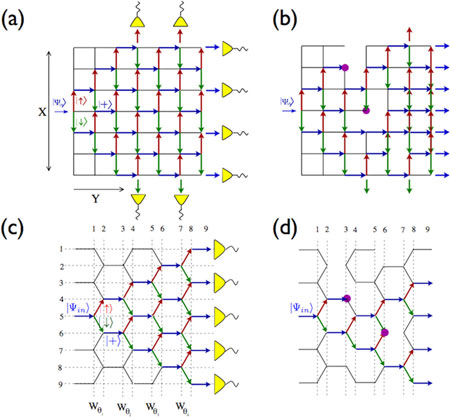| Posted: Oct 23, 2014 |
Moving in the quantum world
|
|
(Nanowerk News) Simulating the behavior of a single particle can be quite a challenging task in physics; after all, it is microscopic and we usually cannot watch in real time. It becomes even more complicated when you realize that the particle has to follow the laws of quantum physics, which allow it be in two or more places at the same time through a phenomenon called superposition. Understanding how a quantum particle behaves is necessary to enhance our fundamental understanding of the laws of physics. Dr. C. M. Chandrashekar, a post-doctoral researcher in Professor Thomas Busch’s Quantum Systems Unit at the Okinawa Institute of Science and Technology Graduate University, is running simulations and carrying out analytical studies to understand how single quantum particles travel. His most recent study has been published on October 10, 2014 in Scientific Reports ("Quantum percolation and transition point of a directed discrete-time quantum walk").
|
 |
| Chandrashekar used lattices such as these to move a particle step by step. Some lattices contained missing connections, creating gaps where the particle cannot travel. (click on image to enlarge)
|
|
The first step to simulating quantum physics is to find the very basic rules that govern the motion of the quantum particle and then add complexity step by step. In Dr. Chandrashekar’s work, a particle is traveling along a lattice, a defined set of paths that looks like a city grid. As the particle travels forward, it approaches a junction where it can go right or left. But under the rules of quantum mechanics, the particle does not have to choose, so can follow both directions and end up in two places at once. The particle’s path begins to look like a branching web, with some paths leading to distant points on the lattice and other paths overlapping and ending on the same point. Paths that lead to the same point can cancel each other, known as destructive interference, or add up known as constructive interference. This movement, where the particle moves and encounters interferences, is known amongst physicists as a quantum walk. At the end of the simulation, Dr. Chandrashekar combines the data into a probability distribution, a graph that represents the probability that a particle is at each point on the lattice at a one moment in time.
|
|
Chandrashekar has simulated quantum particles traveling on different grids and has analyzed the probability distributions for each one. His special interest is in more complicated lattices, which contain broken junctions where the particle can no longer proceed. For each simulation, Chandrashekar found a way to mathematically describe the dynamics of the particle and find the corresponding probability distribution.
|
|
“There’s a strong probability of the particle being around one location, despite it having the possibility to be anywhere” Chandrashekar said, “and it is quantum interference that is causing that.”
|
|
Having a model for this process also means that he can reverse the walk; that is, he can work backwards from the probability distribution to predict the initial position of the particle and the way it has moved.
|
|
“Any discrete space is like a lattice”, Chandrashekar said, “but often they are rather complex.” Any continuous space can be mapped onto fragments in order to be simplified. Then, Chandrashekar can make the gaps between fragments infinitely small and perform the simulation again. “At the end we let the gap between the fragments go to zero,” Chandrashekar says, “and you have a continuous space back.”
|
|
Understanding the motion of a quantum particle has a broad range of impacts. It will help to advance ideas in quantum computing, allowing computers to store and process more information using the same amount of memory and power. It will help understand fundamental transport processes for electrons or energy in complex systems. The simulations using a hexagonal lattice illuminate parts of nanoscience, such as carbon nanotube designers who rely on graphene’s hexagonal structure.
|
|
“You see certain observations and you ask, ‘What led to this?’” Chandrashekar says. “Quantum walks might be responsible for some processes we have not yet understood”.
|

